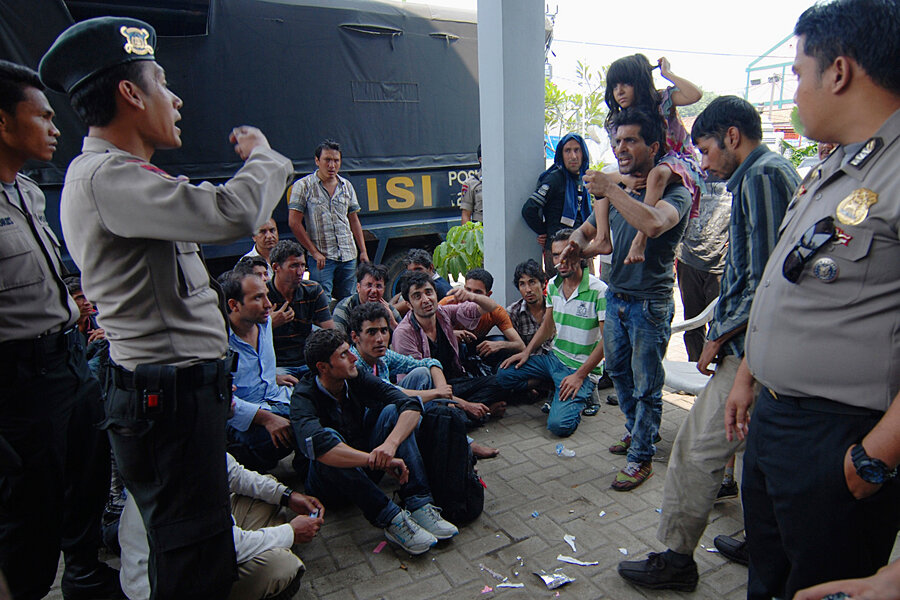In Indonesia, an Afghan refugee family’s uneasy odyssey
Loading...
| Cisarua, Indonesia
Sangita Bashardost lives with her parents and four siblings at a resort in the mountains south of Jakarta. They have a television set, a portable computer, and a yard with a swing for her younger brothers. They pass the days drinking tea and chatting with neighbors, but the days are less idyllic than the setting.
After years of hoping for asylum in Australia following a short stay in Indonesia, this Afghan refugee family and 1,000 to 2,000 others in Cisarua suddenly risk being rounded up and pressured into returning home.
“[Indonesian] immigration is saying we can’t stay in Cisarua, so where to go now? It’s very dangerous,” Sangita, 16, says as her mother looks at the ground on their open-air balcony and her father sits silently behind them.
Her family has been rejected for United Nations asylum, which would guarantee a permanent stay outside Afghanistan. Then they learned Australia is no longer taking people without visas as it did until last year. Now Indonesian authorities say refugees, particularly young men, are angering locals in Cisarua by making sexual advances on Indonesian women.
The tipping point came when Indonesian officials told the International Organization for Migration (IOM) about six months ago to move its 400 sponsored asylum-seeking families out of Cisarua to head off further friction with locals. That order has drawn Indonesia’s attention to people not on the organization’s roster.
“It will become more clear that these people are not under IOM care and weren’t supposed to be there anyway,” says Denis Nihill, chief of the organization’s Indonesia mission. “There were large numbers who were creating tensions in the local community. Local people would go [complain] to the governor’s offices and local governors to Jakarta.”
Indonesia’s immigration department was adding up the illegal population in Cisarua in October and will try to deport them, says Junita Sitorus, assistant to the department’s public relations manager. “Before they are deported they will be detained,” Ms. Sitorus says, declining to give details.
Risky alternatives
The alternative to a crowded and possibly dirty, uncomfortable detention center is returning to dangerous conditions in Afghanistan, Iran, or Iraq.
Ms. Bashardost’s family stays at Ubersam Cottage, a spacious mountain resort almost all occupied by refugees, because they were rejected for UN refugee status. They fear a return to their native Afghanistan, where her father served in a pre-Taliban government and is worried about retaliation.
The IOM had supported the family, his daughter said, but in October they received notice of an end to their $125 monthly stipend plus lodging costs.
They paid more than $5,000 per head two years ago for passage to Indonesia, known for loosely patrolled shorelines, and applied for asylum. The United Nations declined the request. “Afghanistan has been in a 20-year war,” Bashardost says. “How can the UN Refugee Agency not know about our country?”
Her family did not sail illegally for Australia since Canberra has posted signs around Cisarua warning it won’t resettle people without visas. Nine of her Afghan neighbors were among 14 who survived in April when their boat carrying 72 refugees capsized en route to Australia.
Cooperation with Australia?
Australia’s tougher policy is expected to reduce trips on makeshift vessels from Indonesia’s Java to Australia’s nearby Christmas Island. Australia had received more than 13,000 refugees a year from 2007 to 2011 after the former Labor government relaxed immigration policies. Australia got stricter this year amid popular demand and rising costs of resettling migrants.
Indonesia warned Australia against forcible return of boats and paying informants, acts that it says could violate its sovereignty. But the country may quietly cooperate.
“As Indonesia’s shores are not nearly as tightly guarded as Australia’s, I suspect Indonesia will increase its border patrols in an effort of turning more boats back at sea,” says Brian Sheley, managing director of Cascade Asia Advisors, a risk assessment firm focused on Southeast Asia.
Some refugees will still try to outfox both countries, he adds. “In the interim, all solutions Australia and Indonesia can concoct are insufficient so long as Afghan officials are not part of the solution,” Mr. Sheley says.
The United Nations High Commissioner for Human Rights says 5.7 million Afghans have returned home over the past 10 years. Afghan authorities discourage fleeing the country and offer no guarantees to those who go back.
Long processing times
Refugees stuck in Cisarua blame the UN for their dilemma, citing long processing times and inexplicable rejections. The High Commissioner had accepted 2,373 refugees in Indonesia as of Sept. 30, making them eligible for long-term residency in Indonesia with charity aid. The agency does not publicize numbers of rejections.
An accumulated 11,000 refugees and asylum seekers had applied as of August, compared to 7,945 for all of 2012, according to UN statistics. Many of the 50 to 60 Ubersam Cottage tenants, mainly Afghans and Iranians with disputes against their governments, have been rejected.
The UN agency says applications take time because of the overall caseload size. Rejection letters provided by refugee seekers cite poor proof of persecution in their homelands.
“This is life, not a game,” says rejected applicant Mohammad Haghighat, an Iranian who fled three years ago after he publicly abandoned the official religion Islam and the government suspended the magazine he was running. “If I go back to Iran, then they’ll kill me or put me in jail.”






